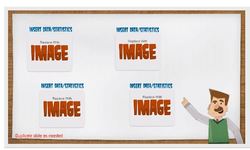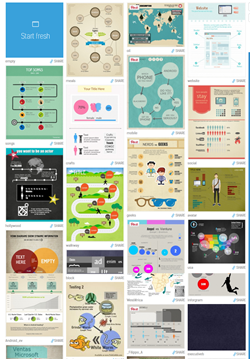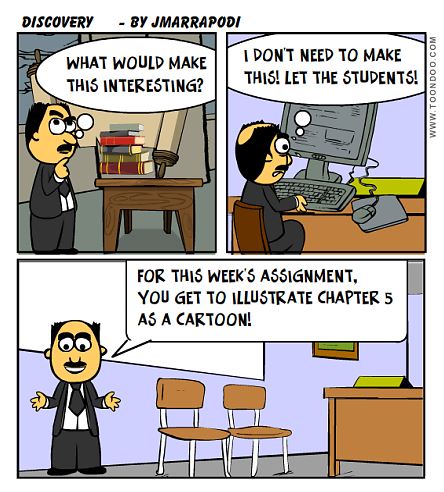The Great Assignments Toolkit
PresentationsConsider having your students create a presentation as an alternative to an essay. This forces student to consider the key points and present them with visual support. Unfortunately, it's really easy to create a bad presentation with PowerPoint. Use these tools to scaffold the design for a better start.
emaze | Free; Pro Version $9/mo; Education pricing available
No more boring PowerPoints! Emaze lets you start with a well designed template and add your content so it appears as if you have worked with a designer. The tool is cloud-based and has the ability to upload a PPT to start. Upgrading to the pro version lets you download and print the file. Emaze Haiku Deck | Free; Pro Version $10/mo; Premium $30/mo; Ed. $5/mo Haiku Deck lets you build picture-based presentations. Linked into 40M searchable Creative Commons images, the content is layered over a different image on each page, providing a fresh look and a focal point to reinforce each concept. One of the hallmarks of the product is the simplicity of each slide. Haiku Deck Prezi | Free w/ .edu email; Pro $4.92/month Prezi starts with a base image, then zooms in for details to tell a story, or present information. Prezi Animation & CartoonsAnimation and comic creator tools make presentations even more interesting. Students will spent considerable time perfecting their end product.

PowToons | Free. Pro version $19/month billed annually.
PowToons allows students to start with animated templates like the one shown on the right. They already contain the animation and the graphics, and music, so students just need to populate the concepts and edit objects as desired. The free version ends with an outtro promoting PowToon. PowToon GoAnimate | Free for 14 days. Teacher pricing $59/year, Single User $39/month. Classroom pricing available. GoAnimate creates animations and whiteboard drawings with synched sound. Voices can be computer generated, or recorded by the students. Here is an example by two of my students. GoAnimate MakeBeliefsComix | Free MakeBeliefsComix is a quick and easy comic strip generator. The characters and backgrounds are somewhat limited, but it is easy to learn and manipulate. Final panels can be printed or emailed. I've used this to generate scenarios in courses. MakeBeliefsComix ToonDoo | Free ToonDoo is a comic creator that generates comics similar to the one below. There is a large variety of searchable characters, objects and backgrounds for students to use. Strips can be posted publicly or identified as private, and can also be assembled into booklets of strips. ToonDoo Make a PuzzleWhen there is a lot of vocabulary or individual items to be memorized, consider using puzzles and student generated flashcards. There is more value in the students generating the puzzles for each other than completing puzzles that are teacher generated. Students must think through the concepts to build the activity. Having them complete the puzzles from other students provides one more layer of reinforcement of the concepts. Always require them to include an answer key, and make sure you require them to use definitions as well as the terms to ensure they learning objective is achieved.
Puzzlemaker | Free
Puzzlemaker allows students to create a variety of puzzles, including word search, crosswords, cryptograms and several other types. Great for reviewing terms and concepts. Puzzlemaker Quizlet | Free Quizlet has a plethora of pre-created flashcards that are great for student study, but requiring students to generate their own flash cards deepens the learning. Cards can contain words, sounds, and images, so it is a great tool for language learners, chemistry terms, vocabulary words, and historical names and places. The possibilities are endless. Making the students generate the cards causes them to review at a deeper level. Quizlet A potpourri of options!50 Sites for Schools | Free
This list provides a nice collection of 50 different resources to enhance your assignments. Some are already on this page, but most are new. 50 Sites |
InfographicsIt is said that infographics convey 250% more information than text alone. Consider requiring your students to present key ideas in this format to aid in better understanding.

Easelly | Free; Pro Version $24/year
Easelly provides hundreds of base images that can be used to create infographics. Students select a base image, then modify the content, changing objects, text, background and colors to fit your assignment requirements. Search features provide lots of different options. Easel.ly Piktochart | Free; Pro Version $39/year (ed price) $120/year/classroom Piktochart is an infographics creator that includes options do design posters. Imagine doing a poster session with your class, similar to conference presentations! Piktochart Flowcharts, MindMaps & DiagramsCould your content be summarized graphically? Consider assigning your students to illustrate a concept using Venn Diagrams, or marketing charts to illustrate the material.
SmartDraw | 30 day free trial, then $197-$497.
SmartDraw lets students build flowcharts, floor plans, wireframes, org charts and tons of other diagrams. It's a one time purchase, and comes with thousands of templates to get you started. Great for explaining concepts, diagramming the flow of ideas, and even generating mindmaps. SmartDraw LucidChart & LucidPress | Free, $4.95/mo; Pro $8.95/mo. LucidCharts comes with limited capacity in the free version, but enough to play around and create some charts and diagrams. They have templates for flowcharts, wireframes, network, education and others. The companion product, LucidPress is for designing print documents and social media illustrations and comes with a nice variety of templates. You can import your images from Flickr, Facebook, Dropbox, or search Google. LucidChart | LucidPress MindMapping Tools | Varies with tool, Free, Pro and Apps
I always plan my designs starting with a key goal that says In the end, the learner will know _______ and be able to _______. This sets the focus. From there, I build a mindmap, adding the outcomes to get there, and from each outcome, I build branches of objectives that deliver the outcome. Attached to each objective, I determine how it will be assessed, then add a description of the content and activity. Using this system, you can see at a glance that you're measuring what you are setting out to accomplish, and nothing is missed. I use a variety of tools, depending on what's available. Mindmeister lets you collaborate in real time; MindManager allows exports to all kinds of things, including Outlook for tasks, but you pay a premium for it. I really don't have a favorite, so I'll list them all so you can try the different ones. MindMeister | XMind | MindManager WritingIf you must give a written assignment, i.e. "Write an essay" or "Write a two page report on xyz", let's at least help our students write with clarity. Here are some tools to help with that.
Hemingway | Free
Hemingway allows students copy and paste their text into the website and it analyzes for clarity, reading level, adverbs, and overly complex words or sentences. Hemingway was known for his concise writing, and this site helps students write that way. There is also a downloadable application. www.hemingwayapp.com/ SlickWrite | Free This website that lets students paste text and check for grammar, spelling and punctuation. You can edit settings for gender and other bias settings. www.slickwrite.com After the deadline/Polish My Writing | Free Another website that lets students paste text and check for grammar, spelling and punctuation. This one will look for passive voice. It also has a downloadable plugin. http://www.polishmywriting.com/ Create a Blog | Free Another alternative to an essay is to have your students start a blog about their coursework. Blog settings can be limited so they can be private, as well as published to the internet for general consumption. Google's Blogger or Wordpress are both easy and free and have many templates to select from to add visual appeal and website builders like Weebly, which is what I use to build this website, have blogging tools on them as well. Here's an interesting how-to article on writing better blog posts that covers things from soup-to-nuts with ideas on brainstorming and driving more traffic to the site. If you're going to have them do a blog, it may as well be a good one. Write a Better Blog Post Brain Games for KidsLily, a volunteer helping Mr. Rizzo at the Center of Northern York gather resources for their media center's resource guide came across my page and offered this gem as something others might find helpful for their students. Thanks for sharing, Lily!
Puzzles, Mind Games and Optical Illusions to Get Your Brain Working | Free
A whole collection of puzzles, riddles, optical illusions and learning games for kids of all ages to help exercise the mind. Brain Exercises The students in Ms. Lyons' class found my page and have been experimenting with some of the tools posted here. They shared this great resource with me, chock full of kid-friendly brain games. They certainly are smart kids to discover and share. That's one of the best ways to learn. Keep at it kids. Thanks!
Brain Games | Free
A whole page of learning games for kids of all ages that involve many of their favorite characters and activities. From the folks at fun.com Brain Games Melissa, a Girl Scout who volunteers with Annie Pruitt at Harrison Park Community Center sent in this suggestion after coming across my page when they were building a guide for their center and thought it might add to the tool kit. Thanks Melissa!
Brain Teasers, Optical Illusions & Riddles | Free
A whole page of links to brain teasers and optical illusions with a slew of riddles for kids of all ages. Perfect for a rainy or snowy day when we're all cooped up in the house. Learning at Home: Free Online Brain Teasers, Mind Games, Puzzles and More! |
Conference
|
Company
|
|

